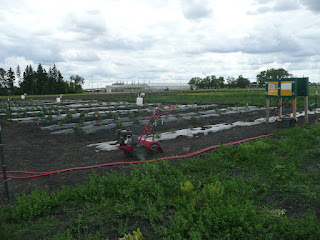 |
| METER WP4C (measurement range: 0 to -300 MPa) |
 |
| Soil Moisture Release Curve (HYPROP 2 + WP4C) |
North Dakota State University (NDSU): Agricultural and Biosystems Engineering (ABEN)

| Seeds Sangria Hybrid Watermelon and Hybrid Determinate Tomatoes Celebrity F1) grew in NDSU Agricultural Experiment Station (AES) Research Greenhouse Complex. |
 |
A
subcompact raised bed mulch layer had been used to lay the mulches and drip
tapes underneath simultaneously. |

 |
| Five watermelon or six tomatoes were planted in each 25ft long plot with two parallel drip tapes installed. |
 |
| Cameras were installed to monitor the growth and dataloggers in the white enclosures were to record the soil water potentials and temperatures in the plots. |
 |
| Field visit and discussion. |
 |
| Harvested watermelon and tomatoes to be tested in lab. |